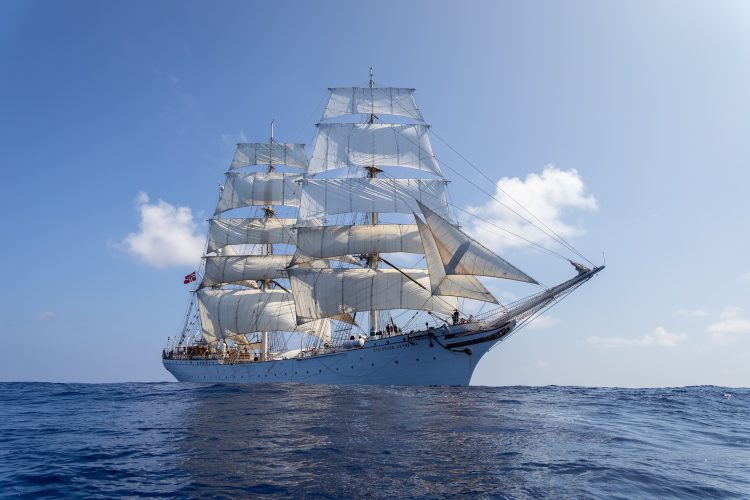TriplePundit • The Century-Old Sailing Ship That Became a Research Vessel

Even sitting in a harbor, Statsraad Lehmkuhl is a sight to behold with gleaming-white sides and three towering masts. The 111-year-old Norwegian tall ship is on a year-long voyage called the One Ocean Expedition, stopping at global ports to raise public awareness of ocean issues. The eye-catching ship may look like something straight out of a history book. Yet, it’s doing modern scientific research as it travels the world.
As some governments around the globe reduce science funding, Statsraad Lehmkuhl offers a model for keeping ocean research afloat on vessels built for other purposes. While it travels, its on-board team and visiting scientists monitor the state of the sea: tracking currents, sampling plankton, recording whale songs and more.
“The ship is sailing anyway,” said Lucie Cassarino, science coordinator of the expedition. “Why not collect data and support ocean science?”
Transforming a piece of history
Statsraad Lehmkuhl, or “Minister Lehmkuhl,” is named for the politician who led Norway in buying the ship from England in 1921. It’s been a sail training vessel for many years, and in 1978, its mission expanded to include public outreach.
In 2021, the ship embarked on the first One Ocean Expedition, sailing around the world as an ambassador for the United Nations Ocean Decade, a global research initiative. On that expedition, Statsraad Lehmkuhl also carried research equipment and collected some data. For the second One Ocean Expedition that launched in 2025, its science capabilities got a serious upgrade.
The preparations started with adding new research instruments, including light sensors and hydrophones (underwater microphones) in 2024. “But you need to monitor all these instruments, and to be able to do that, you need space,” Cassarino said.
So, the ship’s former gift shop was converted to a science lab. That way, scientists had room to collect and examine samples and process data while sailing. In 2025, Cassarino and fellow coordinator Natacha Fabregas were hired to lead the onboard research.
Making science affordable
Statsraad Lehmkuhl’s funding comes from organizations that charter it for research or training, such as the Norwegian Naval Academy. Members of the public can also book passage for certain legs of travel. Membership fees, donations, and government and company partners provide further financial support.
Since the One Ocean Expedition is already funded through these structures, scientists can easily book a research trip on Statsraad Lehmkuhl, and they only pay for their own ticket. For comparison, a standard research cruise can start at $2,000 per day just to charter the vessel, plus other costs like equipment, food and planning. Meanwhile, an upcoming week-long trip aboard Statsraad Lehmkuhl is about $1,200 per passenger.
“It’s less expensive for scientists to come on board, so it’s already helping because they have the opportunity to still go in the field with less money,” Cassarino said. Plus, a normal research vessel only accommodates about 30 scientists. Statsraad Lehmkuhl can take 150 people along.
The ship’s team can even assist scientists who can’t travel on board. “We offer to take samples for anyone who has a project that can be done on board, and for free,” Cassarino said. The external scientists provide the equipment, and Statsraad Lehmkuhl’s researchers collect the data or samples they need.
While modern research vessels offer modern comforts, but the Statsraad Lehmkuhl experience fosters natural connections. Everyone is expected to help with sailing and keeping watch. Scientists, students and public passengers all sleep in hammocks in one large room. Camaraderie grows, and navigating the sea becomes a collective activity.
Experiencing the seas
The ship can’t do long-term monitoring of a single location as it travels the world, but it can illuminate global ocean conditions. “We want to collect a lot of data,” Cassarino said. “If you want to do a climate model, for example, to predict the future, you need a lot of data. You need worldwide data.”
The data collected on Statsraad Lehmkuhl includes observations of plankton growth, ocean currents, temperature changes and pollution levels. The team also transmits this information online, so other researchers can use it right away.
“There are a lot of features of the ocean we have seen that were really amazing,” Cassarino said. She recalled an ocean eddy, a temporary phenomenon of swirling water, in the Norwegian Sea: “Imagine a tornado in the water, but 100 kilometers [62 miles] in diameter.”
The water spiraled down into the center of the eddy, which was large enough to be seen from space. As they sailed toward it, another eddy began forming nearby. In that one, the water swirled up instead of down, attracting marine life as it carried nutrients from the depths of the ocean. The ship changed its route so the researchers could sample both to see how they affected biodiversity.
Unlike traditional research vessels, Statsraad Lehmkuhl can’t hold certain heavy-duty equipment, like a large winch with a cable for sampling the ocean depths, Cassarino said. But it easily carries smaller instruments, such as hydrophones to monitor underwater sounds. Researchers have already picked up whale songs on this year’s voyage. Cassarino shared the high-pitched, whistling songs of pilot whales with the public at an onboard event when the ship stopped in Seattle.
The quality of those samples received a boost from the ship’s sails. Many research vessels have powerful diesel engines, meant to move through strong currents or hold one position. Though useful, these large engines create emissions and noise. While Statsraad Lehmkuhl has an engine, the team tries not to rely on it.
“Every time there’s an opportunity to sail, we sail,” Cassarino said. “So we make less noise, and for the hydrophone data, it’s better.” Sailing also reduces air pollution and saves money on fuel.
A global perspective
While every ship is different, there’s potential for similar projects on other large ships. A past collaboration between Royal Caribbean Cruise, academic institutions, and United States government agencies used cruise ships to gather marine data. But given shrinking science budgets in governments and academia, such projects may need creative sources of funding. One emerging initiative, Positive Polar, plans to fund wildlife restoration research with recreational cruise revenue.
Smaller-scale efforts are another option. The SurfStainable project aims to enlist surfers and recreational sailors in collecting samples, images and data for science by outfitting recreational ships and surfboards with small research instruments.
Involving the public can also help more people see the value of ocean science. Each time Statsraad Lehmkuhl arrives somewhere, its public draw is clear. “When you come into port, people want to visit it,” Cassarino said. “People are just like, ‘Wow!’”
During public outreach events, she’ll invite guests to help with tasks like water sampling for a memorable, hands-on experience with research. “I think the best way of making a change is actually to talk to people,” she said. “To show them things and explain them, take the time.”



Post Comment